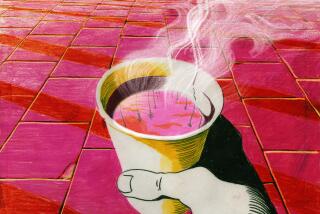Wake Up and Smell the Magnetically Altered Coffee
- Share via
It wasn’t long ago that a cup of coffee was either decaffeinated or regular, and that was about it. Then came lattes and cappuccinos and espressos and iced decaf mochas and assorted other concoctions.
As advanced as those variations are compared with the original brew, they may pale in comparison with what is on the horizon--coffee made from beans whose atomic particles have been adjusted.
That is the latest challenge for Ronald Weinstock, chief executive of Magnetic Resonance Diagnostic Corp.
The Thousand Oaks company develops and manufactures magnetic resonance devices and has developed a patented method for analyzing the magnetic resonance pattern, or atomic particle movement, of many substances--from biological tissue and organs to drinking water.
And now coffee beans, thanks to a joint venture between Weinstock’s operation and the Puroast Coffee company of Woodland in Northern California.
Officials of the two companies have spent the past six months developing a line of coffee dubbed Resonance Roast, which they hope to have on store shelves by summer.
“We’ve taken batches of coffee beans and done magnetic resonance analysis to them and identified the areas in a bean that give it its positive attributes,” Weinstock said. “Once we have the resonance pattern figured out, we can create a magnetic resonance field that is geared to bringing out the positive attributes of the bean even more.”
A magnetic resonance pattern is the way protons, neutrons and electrons move within an atom. Once an optimal pattern has been achieved for a single bean, Weinstock said, it can be applied to other beans from the same batch.
The result, he said, are coffee grounds that are more crystalline in structure and a final product that is smoother and richer in taste.
Magnetic Resonance Diagnostics, a privately held company established in 1993, traditionally manufactures magnetic resonance instruments for therapeutic and industrial uses such as treatment of drinking water and pain control.
“Pain reduction is a far cry from coffee,” Weinstock said. “But most substances, if they have a biochemical or biological process, can be enhanced using specified magnetic resonance patterns.”
Kerry Sachs, president and chief executive of Puroast, said more testing remains to be done before Resonance Roast is ready for marketing. But he is already seeking distributors both domestically and abroad and has received positive responses from Japan in particular.
“This is something you wouldn’t have envisioned a few years ago,” said Sachs, who was introduced to Weinstock by a mutual business acquaintance. “It’s two companies with frontier technology looking for ways to work together.”
Sachs said he did not know what the retail price of Resonance Roast might be, but he expects it to be higher than that of regular gourmet coffees.
Regardless, Weinstock is excited about its prospects.
“I think it will create a lot of curiosity at first,” Weinstock said. “And once people try it, they will have no doubt of the quality of the product.”






